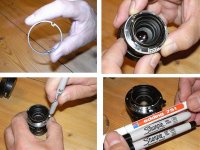adamduckworth
Adam Duckworth
New Leica owner so excuse the ignorance...
I have the 35mm f2. Lovely.
I have the chance to buy a 21mm f2.8 Elmarit. Not 6bit, not Asph.
Would this be a wise move as it's half the price of the latest 6-bit Ashp (both used)?
Would I notice a difference? Should I buy it and pay to get it coded?
Or one of those DIY code kits?
Some advice please, Leica people.
Thanks
Adam
I have the 35mm f2. Lovely.
I have the chance to buy a 21mm f2.8 Elmarit. Not 6bit, not Asph.
Would this be a wise move as it's half the price of the latest 6-bit Ashp (both used)?
Would I notice a difference? Should I buy it and pay to get it coded?
Or one of those DIY code kits?
Some advice please, Leica people.
Thanks
Adam



